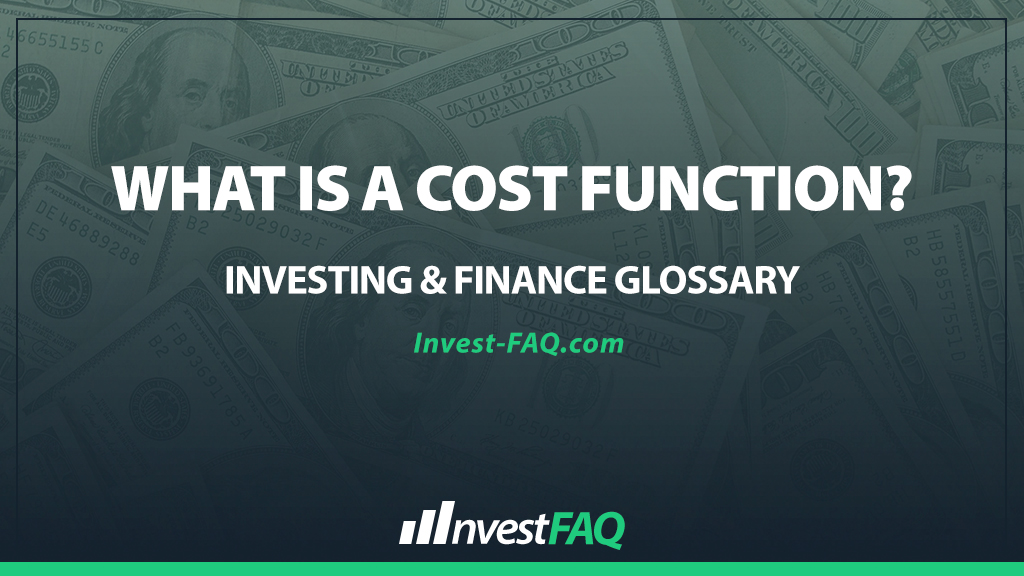
Cost Function
Contents
A cost function is a mathematical formula used to determine the total cost of production or operations based on variable factors such as input costs, labor, and production volume. It represents the relationship between the cost and output level, providing a comprehensive view of how costs change with variations in production activity.
In business, a cost function is essential for planning, budgeting, and decision-making processes. It helps managers and accountants understand the dynamics of cost behavior in relation to changes in production levels, facilitating more accurate forecasting and strategic financial planning.
By analyzing cost functions, businesses can identify the most efficient production levels, optimize pricing strategies, and improve overall profitability.
Example of a Cost Function
Imagine “XYZ Manufacturing” produces widgets, with fixed costs of $10,000 for machinery and rent, and variable costs of $5 per widget for materials and labor. The cost function can be represented as C = 10,000 + 5Q, where C is the total cost and Q is the quantity of widgets produced. If XYZ decides to produce 2,000 widgets, the total cost can be calculated by substituting Q with 2,000 in the cost function, resulting in C = 10,000 + (5 * 2,000) = $20,000.
In this scenario, the cost function C = 10,000 + 5Q helps XYZ Manufacturing understand how its total costs are affected by production volume. The fixed cost of $10,000 remains constant regardless of the number of widgets produced, while the variable cost increases linearly with production volume at a rate of $5 per widget.
This information is crucial for XYZ to determine the break-even point, project profits at different levels of production, and make informed decisions about scaling operations, pricing products, or implementing cost-saving measures.
Types and Uses in Business Scenarios
Cost functions are applied in a variety of business scenarios, including:
Break-even Analysis: Determining the production level at which total revenue equals total costs.
Profit Maximization: Identifying the production level that maximizes the difference between total revenue and total costs.
Budgeting and Forecasting: Estimating future costs and setting budgets based on projected production levels.
Cost Management: Analyzing how changes in production volume affect costs to find opportunities for efficiency improvements.
The versatility of cost functions makes them a valuable tool for financial analysis and strategic planning across all sectors of business.
Significance for Investing & Finance
From an accounting perspective, the concept of a cost function is significant for several reasons:
Accurate Cost Allocation: It allows for the precise allocation of costs to products, services, or projects based on their consumption of resources.
Financial Planning: Cost functions provide a basis for detailed financial planning, helping businesses anticipate changes in costs relative to production decisions.
Strategic Decision-Making: Understanding the relationship between costs and production volume supports strategic decisions regarding pricing, investment in production capacity, and cost control initiatives.
In summary, a cost function is a fundamental analytical tool in both accounting and management, enabling businesses to model cost behavior and make informed decisions about production, pricing, and financial planning.
By accurately depicting how costs vary with changes in production volume, cost functions play a crucial role in optimizing operational efficiency and profitability.
FAQ
How does a cost function help in determining the break-even point for a business?
A cost function allows a business to calculate its total costs at various production levels; by setting this equal to the total revenue function, a company can determine the break-even point, where total costs and total revenue are exactly equal, indicating no profit or loss.
Can a cost function vary between different types of products or services within the same company?
Yes, cost functions can vary significantly between different products or services due to variations in materials, labor, and other cost drivers specific to each product or service, necessitating separate cost function analyses for accurate financial planning and analysis.
What is the importance of understanding the variable and fixed components in a cost function?
Understanding the variable and fixed components in a cost function is crucial for cost management and pricing decisions, as it highlights how total costs change with production volume, enabling businesses to optimize pricing strategies and control costs more effectively.
How can a cost function impact a company’s pricing strategy?
A cost function provides insight into the minimum costs associated with producing a product or service, enabling a company to set prices that cover costs and achieve desired profit margins, while also considering competitive pricing and market demand.
